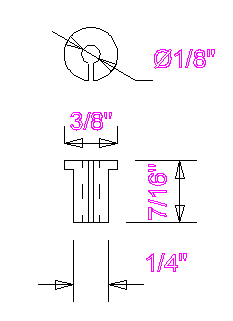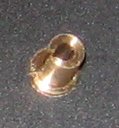I’ve recently been making a Stuart 10V with the help of the Andrew Smith/Pengwern building guide. At one point they recommend the use of a split bush to afford a greater degree of concentricity in turning the piston rod (and both the piston and cross-head attached to this). A sketch of the split bush is provided with the throw away comment that its use requires no description. OK, that much I agree with but the making of the device led me astray.
The basic idea of the split bush is to get around the fact that the lathe chuck is likely to be a wee bit off truely concentric to its rotation axis. i.e. even perfectly cylindical rod in an unworn chuck will not rotate about its centre. The split bush is bored in situ, which does guarantee the hole is centred on the axis of rotation and the work is held in the hole. In the 10V, there is a 5/32″ piston rod and 1/8″ valve rod that need to be treated in this way. By the way, I use a Warco 918, a relatively cheap Chinese lathe and I have demonstrated that the chuck is about 0.001″ out.
How to Make a Split Bush Properly…
(this one did indeed seem to be right – I checked quite carefully)
- Face the end of some brass and turn down the 1/4″ section.
- Part off or remove and saw off
- Re-chuck, ensuring the shoulder seats on the chuck nose “nicely”
- Face off, centre drill, drill 3mm and ream/D-bit 1/8″ (I love mixing units)
- Identify one of the chuck jaws (I centre punched the chuck backplate) and mark the nascent bush to it may be precisely aligned with this jaw. A light centre-punch is nice and permanent.
- Remove the piece, insert a piece of rod into the centre and cut the slot in the opposite side to the marked point. The rod avoids hard-to-remove swarf buildup in the inside which will interfere with the workpiece. I’ve started using a Dremel tool for little jobs like this.
- Return to the lathe chuck, reseat carefully and lightly tighten the chuck, insert the work piece, tighten the chuck fully and there you are…


Very useful item Adam – thanks for taking the time to post this.
I have just started model engineering/metalwork – have flown, crashed and repaired radio controlled aeroplanes and helicopters for years, and have always had a “hankering” to have a go at some “proper” model engineering.
My lathe and drill press (plus other bits and bobs) should hopefully arrive next week – I have made a start of the Stuart 10V unmachined castings at the weekly evening classes I go to, so am very interested with your suggestion re the split bush.
I have also downloaded your “Tower of Hanoi” info. as a project for me to do at some stage.
Many thanks for the blog, A
Hi Adam,
I did not know how to make a chucking bush either and like yourself had a major ? as to how to construct same.
Your post was very welcome
Regards
I think an important parameter is the eventual tailstock excentricity versus headstock when drilling /reaming the bush. So a better practice is to BORE it (single point boring) to guarantee the concentricity with the outer diameter.
@michael – yes, I would always bore a larger chucking piece as you say.
The case in point is a bit on the small side, though (1/8″)…
Adam